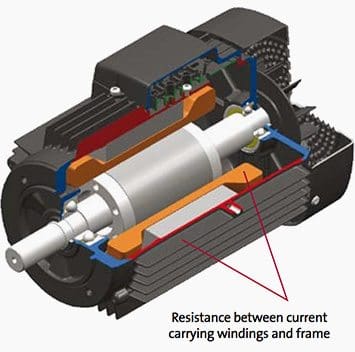Winding insulation resistance
If the motor is not put into operation immediately upon arrival, it is important to protect it against external factors like moisture, high temperature and impurities in order to avoid damage to the insulation. Before the motor is put into operation after a long period of storage, you have to measure the winding insulation resistance.
If the motor is kept in a place with high humidity, a periodical inspection is necessary.
It is practically impossible to determine rules for the actual minimum insulation resistance value of a motor because resistance
varies according to method of construction, condition of insulation
material used, rated voltage, size and type. In fact, it takes many
years of experience to determine whether a motor is ready for operation
or not.A general rule-of-thumb is 10 Megohm or more.
| Insulation resistance value | Insulation level |
| 2 Megohm or less | Bad |
| 2-5 Megohm | Critical |
| 5-10 Megohm | Abnormal |
| 10-50 Megohm | Good |
| 50-100 Megohm | Very good |
| 100 Megohm or more | Excellent |
The measurement of insulation resistance is carried out by means of a megohmmeter – high resistance range ohmmeter. This is how the test works: DC voltage of 500 or 1000 V is applied between the windings and the ground of the motor. Ground insulation test of a motor
During the measurement and immediately afterwards, some of the terminals carry dangerous voltages and MUST NOT BE TOUCHED.Now, three points are worth mentioning in this connection: Insulation resistance, Measurement and Checking.
Click here for the full article

No comments:
Post a Comment